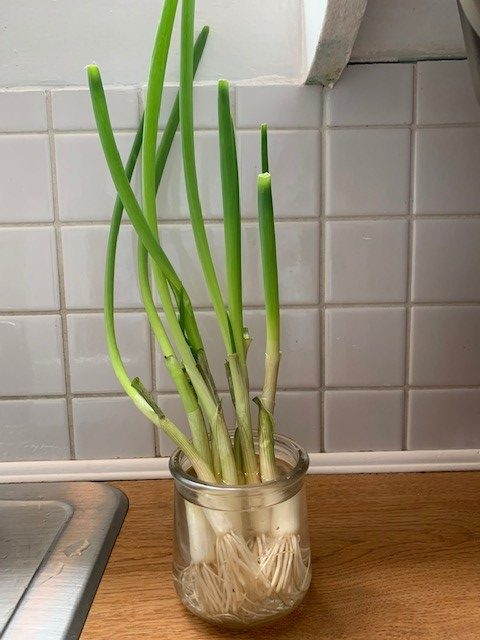
by Guest | May 22, 2020 | Eat Well
AUTHOR: Elizabeth Parker
Did you know that several of your kitchen vegetable scraps can be used to regrow those vegetables? Green onions, lettuce and celery can be regrown within days in the comfort of your home – no garden or dirt needed. Not only is it a fun experiment in the kitchen, but it’s also quite resourceful and easy to do.
All you need is your vegetable scraps, a small container, water, and a nice sunny spot.
To regow your vegetable, place the roots or heart of the vegetable in a container with about an inch of water. Place in a sunny spot and watch the vegetable grow, and in about a week you’ll have fresh produce to reuse. Change out the water every couple days to keep the water fresh and encourage more growth.
Green onions are the easiest vegetable to regrow. Here’s a timeline of the how quickly they grow.
Day 1:
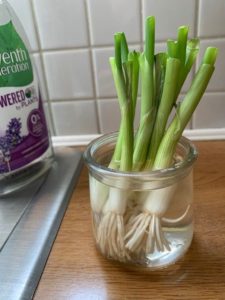
Day 2:
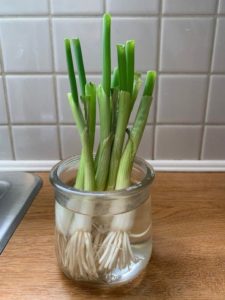
Day 3:
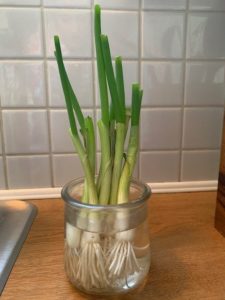
Day 4:
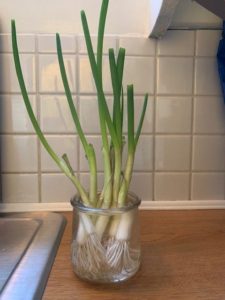
Day 5:
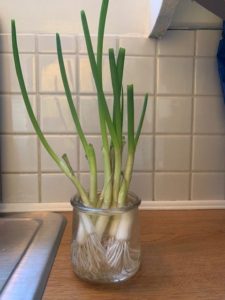
Day 6:
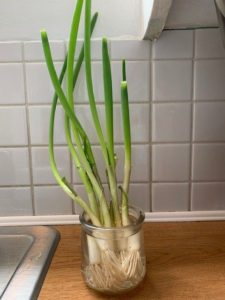
Then the green onions were chopped up and used in this tasty Veggie Quiche Muffin recipe from Food Hero.
Try regrowing some of your vegetables at home and share your success with us! Happy “gardening”!
For more local health and wellness information, follow Tillamook County Wellness on Facebook, Instagram and Twitter.
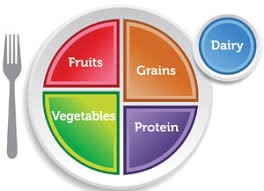
by Guest | Apr 17, 2020 | Eat Well
By: Dusti Linnell, PhD, OSU Extension Service, Tillamook and Lincoln County & Anne Goetze, RDN, LD, Oregon Dairy and Nutrition Council
Restaurants are closed for dining in right now, but many in Tillamook County are open for Take-Out. In fact the Tillamook Chamber of Commerce has compiled a list, Take Out Time, with restaurants, hours and phone numbers. You can even join the Facebook group “Tillamook Coast Takeout + Delivery” for menus and specials. This is an important time to support your local businesses. It is also a great opportunity to Eat Well.
It may feel like time to binge eat or stress eat, but eating well is important now in order to help you and everyone in your house stay healthy and well. We are here to help! In January, we posted the following article, “Eating Out and Eating Well.” We’ve made a few edits for take-out and are sharing it again with you now. Remember safe food handling to avoid the spread of disease. Wash your hands before touching food.
Eating Out and Eating Well – Take-Out Edition
The Dietary Guidelines for Americans show us that most Americans typically do not get enough vegetables, dairy, whole grains and even fruit. While most get too much sugar, fat, salt and too many calories. Using MyPlate as your guide, even when you are ordering take-out can help you choose well. A simple way to approach food choices is to think about the food groups pictured in MyPlate.
When you order, think about what you’ve already eaten that day and what you might eat the rest of the day. What’s missing? What can you choose so that at the end of the day, your virtual MyPlate will be balanced and full, but not overflowing?
Here are a few tips for things to think about when you order:
-
Boost fruits and veggies.
- Add or substitute red, orange, or dark green vegetables whenever you can. Try arugula or spinach instead of lettuce, even on a burger.
- Get the most from side dishes. Try green salad, fruit, corn, beans, or vegetable soup. Order as part of your take-out meal, or keep these foods in your fridge or pantry to serve with your meal.
- If you are going to eat dessert, choose pie, cobbler or other food where fruit is the main ingredient.
- Ask for whole wheat sandwich bread, burger buns, tortillas or pizza crusts.
- Look for deli salads with grains like bulgur, quinoa, wheat berries and even brown rice.
- Add a slice of cheese to a sandwich or burger.
- Order a carton or bottle of milk.
- Choose yogurt or a yogurt parfait.
- Instead of soda, order milk, 100% juice or unsweetened iced tea with lemon.
-
Skip the cookies, or have just one.
Here are some ways you can put these tips into action:
-
Chicken teriyaki? Ask for extra veggies on the side. For a family, order a large chicken teriyaki and a salad to share.
- Craving that delicious macaroni and cheese? Great! Order a cup of tomato soup to go with it and save half (or more!) of the macaroni and cheese for tomorrow’s lunch.
- Ordering a peperoni and cheese pizza? Add peppers and onions. Order salad to eat with the pizza.
- Thinking about Thai food? Many of the dishes are full of veggies with great lean protein choices. Beef noodle soup, curry, and pad Thai are great choices and ask for extra veggies.
- Hungry for an awesome burger? Enjoy it, but request extra pickles, lettuce, tomato, or onion. You could also order a small or kid size burger and a salad. Make it a cheeseburger. Think about ordering one burger for two people.
- Ask your favorite coffee drive-thru for a mocha that is half-sweet.
- Ordering a burrito? Request extra pico de gallo and whole beans instead of refried. Need more dairy? Order extra cheese. Too many calories? Skip the rice.
- Is it barbeque day? Don’t skip the coleslaw. Made with cabbage and carrots, coleslaw counts as a vegetable.
-
Grabbing a quick sub sandwich? Order whole wheat bread and extra veggies like spinach and bell peppers. Grab a bottle of milk to make it a meal.
Take Out Time, can also be Eating Well time. Let MyPlate be your guide, try some new options and find what is right for you.
For more local health and wellness information, follow Tillamook County Wellness on Facebook, Instagram and Twitter.
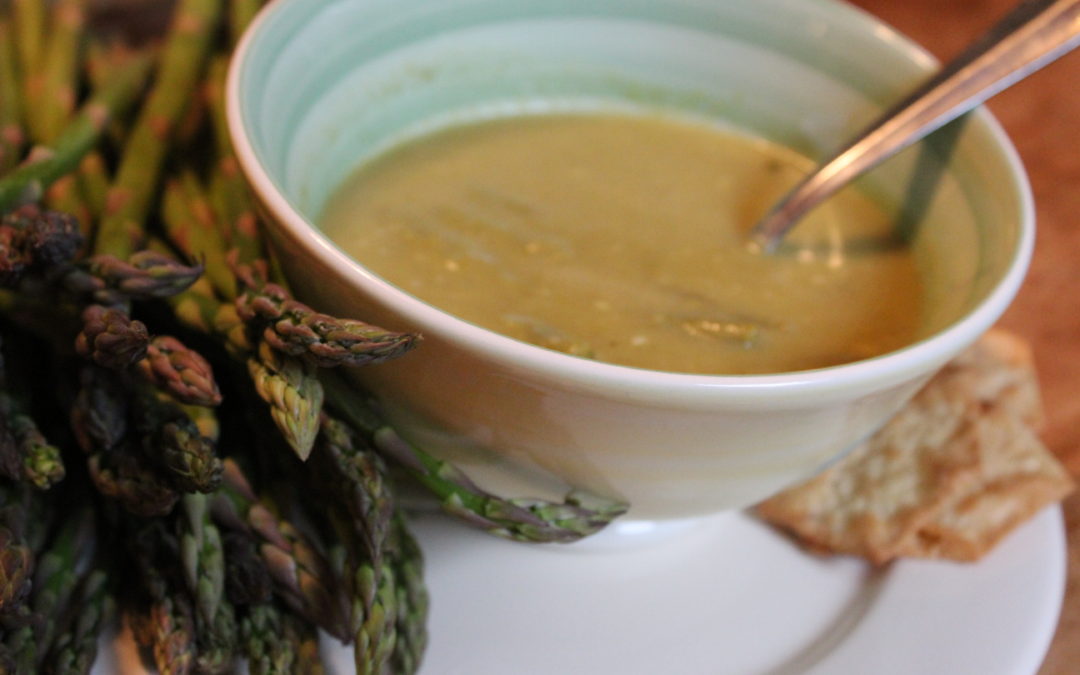
by Guest | Apr 10, 2020 | Eat Well, Recipes
By Laura Swanson
Every vegetable has its season, and for me, a favorite is “asparagus season” – when the first early Spring crops arrive and the price per pound drops. There are so many ways to prepare asparagus – classic steamed; drizzled with olive oil and balsamic vinegar, roasted with garlic of course; and pickled. Yes, pickled asparagus spears – oh, yum!
One of our family traditions is to prepare “Spring Asparagus Soup” for St. Patrick’s Day. It’s perfect for our Irish heritage (my mom’s maiden name was Fitzpatrick) to have green soup and corned beef. This soup is quick and easy to prepare, low in calories and asparagus is such a nutrient rich vegetable.
Asparagus is a young tender shoot (spear) vegetable, which emerges from its underground root system. Their use as food was well recognized by the ancient Greeks and Romans as a prized delicacy. One of the oldest recorded vegetables, its thought to have originated along the coastal regions of eastern Mediterranean and Asia Minor regions. Botanically, it is a herbaceous perennial plant (meaning it will come back year after year with a little attention and maintenance) belonging to the Asparagaceae family. It is closely related to the Liliaceae plants which also include onion, garlic, tulip, daffodil, etc – all the heralds of Spring. Plant asparagus crowns in early spring, and once established, this plant can provide an abundance of healthy spears after a couple years. Young scaly edible spears emerge from the underground extensive matted root systems, which can be ready for harvest in early Spring in some areas, usually by late Spring here on the Oregon Coast. When I see my asparagus making an appearance in the garden, that’s when I know it’s Spring.
Asparagus is a very low-calorie vegetable. 1 cup (134 g) fresh spears carry just 40 calories. Fresh asparagus is a good source of dietary fiber, Vitamins A, C, E and K, as well as the B vitamins. Asparagus is an excellent source of minerals, copper, iron, calcium, potassium, manganese, and phosphorus.
This soup is so easy to prepare, elegant and very nourishing. And if Spring had a flavor or taste – it’s Asparagus soup! Serve it for your Easter dinner, and when it’s spring asparagus season – stock up! The soup freezes well, too. You can use vegetable stock and then it is vegan/vegetarian and is also gluten-free.
SPRING ASPARAGUS SOUP
Serves 8
Ingredients:
2 1/2 lbs. asparagus
3 T. butter
1/2 C. minced onion
4-6 cloves of garlic, minced
1/2 t. ground coriander
4-6 C. chicken or vegetable stock
Salt and White Pepper
Directions:
-Steam asparagus to tender, bright green.
-Cut tips and reserve. Cut remaining stalks into 1″ pieces.
-Sauté onion, garlic and coriander in butter in large heavy pan, until soft, not browned.
-Add asparagus stalks. Simmer 10-15 minutes
-Puree in blender or with submersible blender
-Pour back in pan; add stock; add asparagus tips. Heat to hot.
-Add white pepper and salt to taste.
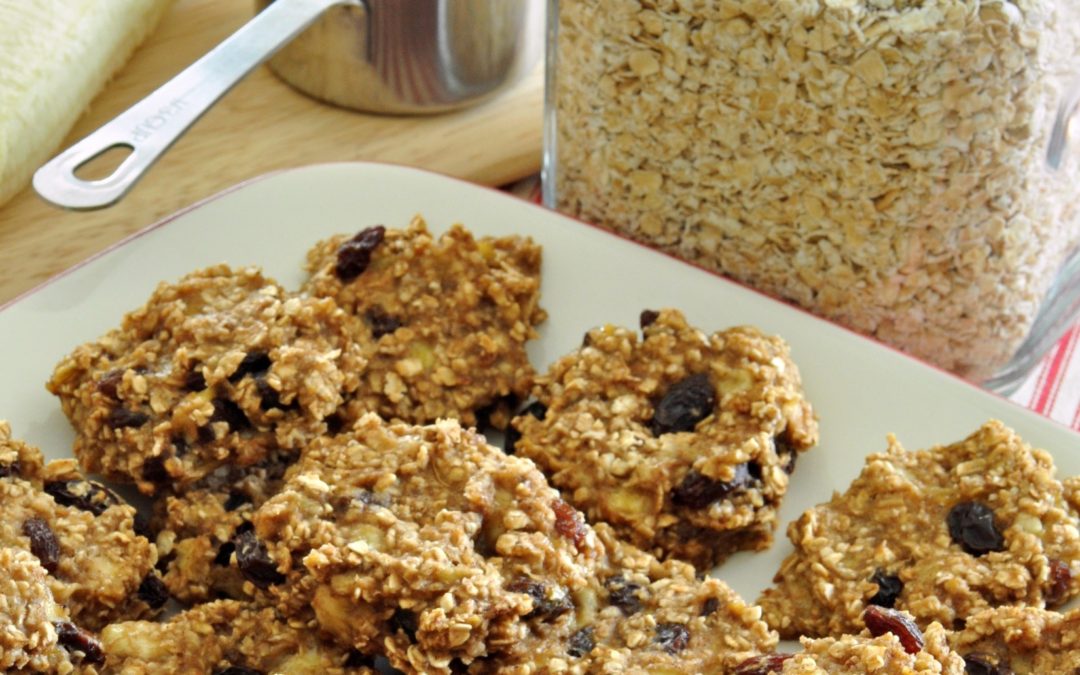
by Guest | Apr 3, 2020 | Eat Well, Recipes
Recipe and photo source: foodhero.org
Number of servings: 7
Time for preparation (including preparation and cooking): 25 minutes
Ingredients:
2 very ripe bananas
1 cup quick oats
1⁄2 teaspoon cinnamon
1⁄2 teaspoon vanilla
1⁄2 cup raisins
Directions:
-Preheat oven to 350 degrees.
-In a medium bowl, mash bananas with a fork until mostly smooth.
-Add oats, cinnamon, vanilla and raisins. Mix well.
-Drop spoonfuls of dough onto lightly sprayed or oiled baking sheet. Flatten with the back of a spoon or bottom of a drinking glass.
-Bake 10 to 15 minutes. Remove from oven and let cool before serving.
Notes:
-Texture will be best when freshly made.
-Try dried cranberries or chopped nuts instead of raisins.

by Guest | Mar 12, 2020 | Eat Well
By: Dr. Eli Andersen, Doctor of Naturopathic Medicine at Rinehart Clinic
When I introduce the idea of fasting with the goal of wellness in mind, some people may be confused. Isn’t a balanced nutritional diet important? Absolutely. And so is balance in all your body’s systems.
Fasting is one approach, among many, to find that balance.
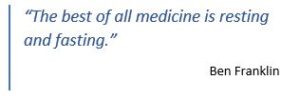
My practice is based on the core principle of Naturopathic Medicine: Vis Medicatrix Naturae, The Healing Power of Nature, meaning that the human body has a natural ability to heal itself. Fasting is very much in line with this as it can help the body find balance and supports healing.
First, a little bit about what a fast is. Merriam-Webster defines fasting as “abstaining from food;” in other words, choosing to not eat food. My definition of fasting is “the opposite of being in a fed state (unfed state).” The science of how fasting works is complex and would take up more room than we can fit in this article, but the bottom line? After a period of time in an unfed state, the body switches from its normal energy source (glucose) and begins to use stored fats as energy since there is limited glucose available in the body from lack of eating; this process is called ketosis. Along with burning fats, in the unfed state, the body is also able to identify cells that are no longer working in the right way and returns itself to a healthier state through a process called “autophagy.” Autophagy starts after 13-18 hours of fasting. At the 24-hour fasting point, autophagy increases significantly.
Fasting has been used throughout human history in times of illness in order to support healing; it also happens universally in the animal kingdom. Scientific research on the benefits of fasting is still in the early stages, but we know from early studies (and from human and natural history) that fasting may be a way to eliminate waste, support the body in its own self-repair, and improve the function of immune cells. All of which could positively impact your health as you age!
Two common types of fast:
-A Short Fast (also known as Intermittent Fast) means eating no food for a block of 12 or more hours in a 24-hour period. A typical short fast might last 16-20 hours with a time blocks (i.e. 4-8 hours) for eating each day. Short fasts can be helpful for weight loss, improved lean muscle mass, improved mental sharpness, improved healing, reducing inflammation in the body, and decreasing sugar and insulin in the blood.
-A Prolonged Fast, best performed with guidance from one’s healthcare provider, can range from 24 hours to several days (or more) and generally leads to more noticeable benefits as you increase the length of the fast. Prolonged fasts may be helpful for chronic diseases, including high blood pressure, type 2 diabetes, insulin resistance, high cholesterol, autoimmune diseases, arthritis, skin conditions like eczema or psoriasis, gastro-intestinal conditions, mental health conditions, and cancer.

One of my patients, who happens to be a Registered Nurse, has been fasting twice a month for the last several months as part of her focus on a healthier lifestyle. After we initially discussed it, she researched more on her own. “After learning more about fasting, the idea just made sense to me, knowing what I know about the body’s ability to heal itself,” she said. “I look at it as a way to let my body rest and my cells rejuvenate. Plus, I have more energy!” Her most recent labs also show improvements in triglyceride and cholesterol levels.
If you would like to learn more about fasting, I will hold a workshop again this fall as part of Rinehart Clinic’s Community Wellness programming. (Dates for the Workshop on Fasting have not been set, but if you are interested in attending, sign up for Rinehart Clinic’s eNewsletter at www.rinehartclinic.org/news or follow us on Facebook for details as they become available.)
As with all health-related routines, if you plan to conduct a fast, you will want to check with your primary care provider first to make sure it fits your particular health care needs.
For more local health and wellness information, follow Tillamook County Wellness on Facebook, Instagram and Twitter.
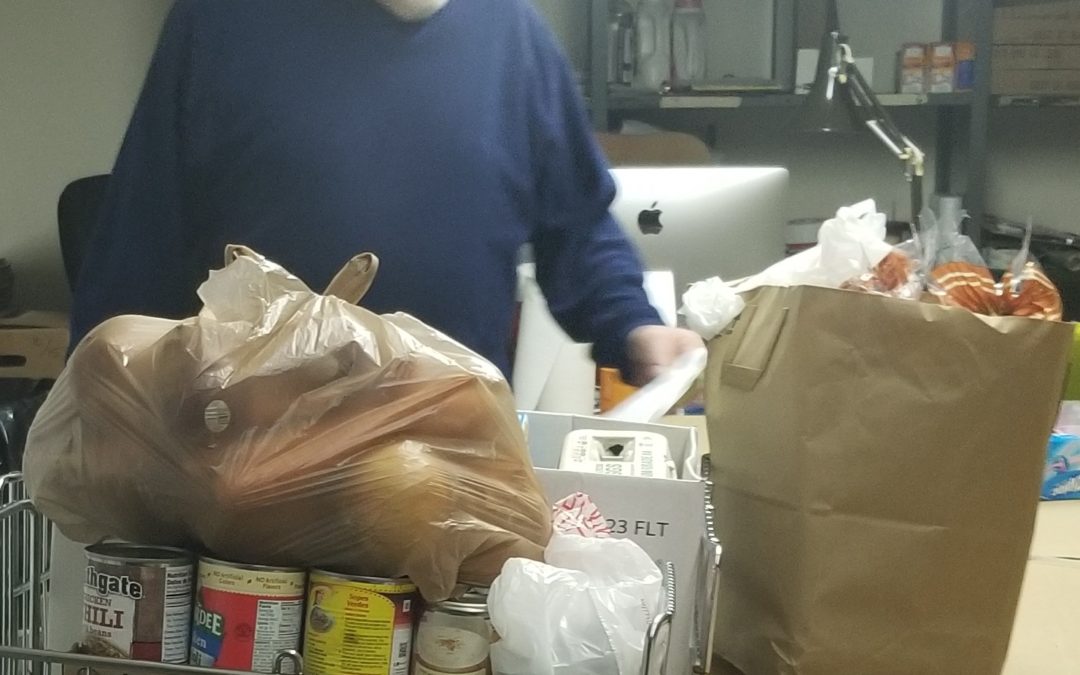
by Guest | Mar 6, 2020 | Eat Well, Recipes
By: Laura Swanson
~in creation of this article, Laura produced a video to capture this unique feature – watch here!~
Tuesdays at the North County Food Bank in Wheeler are busy – starting early to be ready to serve the folks that will begin arriving before noon. There is an efficient orderly process as the customers check in, take their number and wait patiently for their turn to receive boxes loaded with a variety of food for meals to feed their household for the coming week. Some also visit the pet food bank supplied by Animal Haven by the Sea, and then there are community members bringing in donations for the clothing bank located down the hall.
Local restaurant owner and chef Jake Burden from Offshore Grill in Rockaway Beach joined Tillamook County Wellness to showcase the amazing efforts of our local food banks to feed our community, and to provide ideas for creative meals. “Cooking is becoming a lost art,” commented Jake. “And we know that many of the people in our community that are homeless or housing challenged, may not even have means, appliances, pots and pans to cook a meal.”
Think “Iron Chef” mystery box meets food bank ingredients, and you’d have the challenge that Jake took on last week. North County Food Bank Board President Tom Ayres walked Jake through the process. “Our customers come in and we do an intake interview to determine household size, food needs, etc.,” explained Tom. “We treat everyone with respect and dignity. We want people to know that there is no shame in accessing these resources. We know there are more people out there that could use the food assistance. This is a big step to reach out for help.”
As Tom reviewed the list of available foods, Jake confirmed if the items were something he wanted and was given choices and options based upon the size of his household.
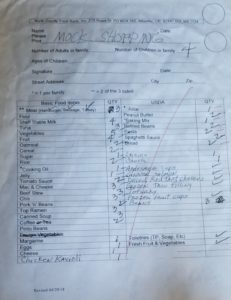
“I was really surprised by the variety, and even in mid-winter, the Food Bank had root vegetables and fresh fruit,” said Jake.
Kicking into chef-mode, Jake was planning the various meals that he could prepare with the foods available. Jake is a father of four and understands first-hand the challenges that many families have when trying to feed a family. “I know how much folks struggle in our communities, some people working a couple jobs, and then you have to come home, cook something everyone will eat, and have it ready in 30 minutes or less, yeah, right,” he chuckled. “Then you might be cooking on a single hot plate, or you’re living in your car. How are you going to cook something, let alone a healthy meal? This is eye-opening.”
The shopping list is completed and the “packing team” takes over – each volunteer has an area assignment, and then volunteer Sue Wilson calls out, “Who’s being Imie?” An honor granted to another volunteer, in memory of long-time Food Bank volunteer and board member Imie Camelli, who passed away last year. Her job was to call out the items on the list for the packers, so that the other team members can quickly and accurately pack several boxes with a variety of foods.
There are staples – flour, eggs, milk, oatmeal, cereal, canned goods, boxed foods, meats, canned and fresh fruits and vegetables, spaghetti and ramen noodles, tuna and a special treat for North County Food Bank locally-sourced canned salmon from the Smiley Brothers Salmon project. As Jake reviews the variety, he can see how families could just open and eat many of these foods, but there are some creative, easy ways to take these simple, everyday ingredients and “kick it up a notch.”
With the ramen noodles, the canned vegetables and the Smiley Brothers canned salmon, we head to Rockaway Beach and Jake’s kitchen at Offshore Grill – and the remainder of the food was returned to the Food Bank shelves to go to a those who need it.
Salmon & Veggie Ramen Noodles
Ramen style noodles are a staple in most households and by adding canned vegetables, a few fresh veggies (onion and carrots) and the canned salmon – ta-da! An Asian-inspired, one-pan meal for a family of four in less than 20 minutes.
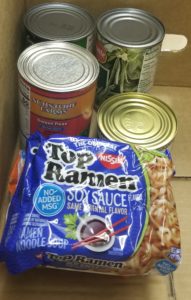
Ingredients
– 2-3 carrots – shredded
-1 medium onion – minced
-2 – 3 cans of vegetables; drained and rinsed
-1 – 8 oz. can of salmon; drained
-3 packages of ramen style noodles
Directions:
-In large saucepan, cook ramen noodles according to package directions
-do not add seasoning packet*
-Add carrot and onion, stir. Cook additional 10 minutes.
-Add canned vegetables and salmon, stir. Heat another 5 minutes.
-Serve!
Really, that’s it.

Additional Notes:
Try substituting canned salmon with canned tuna.
-Consider using more than 1 can of canned salmon or tuna, as for four people, one 8 oz can is only 2 oz of salmon per serving.
-See Myplate for more information on recommended serving sizes.
-For added protein consider whisking up 1-2 eggs and adding those to the hot soup near the end of the cooking.
*If wanting to add more flavor, try adding 1 or 2 of the seasoning packets from the ramen noodles as directed on the package.
As Jake wrapped up the cooking, he mentioned a Cooking Matters session he did several years ago with OSU Extension. “We need to teach people how to cook again,” he said. “I really enjoyed those classes and sharing my love for cooking with the community. Our society needs to get back into the kitchen. There is nothing more satisfying than providing nutritious food to your family and friends. It’s one of the most basic nurturing things we can do, but we’ve lost touch with that.”
Offshore Grill is located at 122 N. Hwy. 101 in Rockaway Beach, seasonal menu that features fresh local ingredients.
North County Food Bank is at 278 Rowe St. in Wheeler and is open on Tuesdays from noon to 3 pm.
For more local health and wellness information follow Tillamook County Wellness on Facebook, Instagram and Twitter.

















